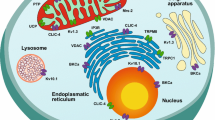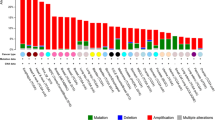Abstract
This chapter is devoted to the study of the role of TRP channels in tumorigenesis in vivo using a tumor xenograft model in immunodeficient mice. Either cancerous cells naturally expressing TRP channels, or TRP channel stably expressing cancerous or normal cells, could be injected into immunodeficient mice. After grafting cells may grow in mice and form the solid tumors which can be measured and photographed. On reaching the critical allowed size the tumors are excised and consequently mice have to be sacrificed. Once excised, the tumors are photographed, weighted, and volume is measured. In addition, tumors may be subjected to further analysis as immunocytochemistry, western-blotting, PCR, etc. To confirm the role of a particular channel on tumorigenesis in vivo, some tumors could alternatively be treated in vivo with TRP channel-specific siRNA. Hence, tumor xenograft model using immunodeficient mice represents a valuable tool for the study of the role of TRP channels in carcinogenesis in vivo.
Access this chapter
Tax calculation will be finalised at checkout
Purchases are for personal use only
Similar content being viewed by others
References
Frank SA. Somatic mutation: early cancer steps depend on tissue architecture. Curr Biol. 2003 Apr 1;13(7):R261-3. Review. PubMed PMID: 12676101.
Spencer SL, Gerety RA, Pienta KJ, Forrest S (2006) Modeling somatic evolution in tumorigenesis. PLoS Comput Biol 2(8):e108
Lehen’kyi V, Prevarskaya N (2011) Oncogenic TRP channels. Adv Exp Med Biol 704:929–945
Prevarskaya N, Zhang L, Barritt G (2007) TRP channels in cancer. Biochim Biophys Acta 1772(8):937–946
Shapovalov G, Lehen’kyi V, Skryma R, Prevarskaya N. TRP channels in cell survival and cell death in normal and transformed cells. Cell Calcium. 2011 Sep;50(3):295–302. Epub 2011 May 31. Review. PubMed PMID: 21628069.
Ding X et al (2010) Essential role of TRPC6 channels in G2/M phase transition and development of human glioma. J Natl Cancer Inst 102(14):1052–1068
Shi Y et al (2009) Critical role of TRPC6 channels in G2 phase transition and the development of human oesophageal cancer. Gut 58(11):1443–1450
Bomben VC, Sontheimer H (2010) Disruption of transient receptor potential canonical channel 1 causes incomplete cytokinesis and slows the growth of human malignant gliomas. Glia 58(10):1145–1156
Yang SL, Cao Q, Zhou KC, Feng YJ, Wang YZ (2009) Transient receptor potential channel C3 contributes to the progression of human ovarian cancer. Oncogene 28(10):1320–1328
Monet M et al (2010) Role of cationic channel TRPV2 in promoting prostate cancer migration and progression to androgen resistance. Cancer Res 70(3):1225–1235
Sharkey FE, Fogh J (1984) Considerations in the use of nude mice for cancer research. Cancer Metastasis Rev 3(4):341–360
Flanagan SP (1966) ‘Nude’, a new hairless gene with pleiotropic effects in the mouse. Genet Res 8(3):295–309
Bosma MJ, Carroll AM (1991) The SCID mouse mutant: definition, characterization, and potential uses. Annu Rev Immunol 9:323–350
Fidler IJ (1986) Rationale and methods for the use of nude mice to study the biology and therapy of human cancer metastasis. Cancer Metastasis Rev 5(1):29–49
Cespedes MV, Casanova I, Parreno M, Mangues R (2006) Mouse models in oncogenesis and cancer therapy. Clin Transl Oncol 8(5):318–329
Wang X, Ponzio NM, Studzinski GP (1997) Long-term exposure of HL60 cells to 1,25-dihydroxyvitamin D3 reduces their tumorigenicity: a model for cancer chemoprevention. Proc Soc Exp Biol Med 215(4):399–404
Author information
Authors and Affiliations
Corresponding author
Editor information
Editors and Affiliations
Rights and permissions
Copyright information
© 2012 Springer Science+Business Media, LLC
About this protocol
Cite this protocol
Lehen’kyi, V., Khalimonchyk, S., Pourtier, A., Raphaël, M., Prevarskaya, N. (2012). Tumor Xenograft Models to Study the Role of TRP Channels in Tumorigenesis. In: Szallasi, A., Bíró, T. (eds) TRP Channels in Drug Discovery. Methods in Pharmacology and Toxicology. Humana Press, Totowa, NJ. https://doi.org/10.1007/978-1-62703-095-3_24
Download citation
DOI: https://doi.org/10.1007/978-1-62703-095-3_24
Published:
Publisher Name: Humana Press, Totowa, NJ
Print ISBN: 978-1-62703-094-6
Online ISBN: 978-1-62703-095-3
eBook Packages: Springer Protocols




